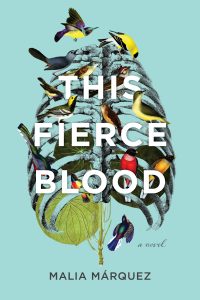Writing Our Ancestors Into Fiction
Writing Our Ancestors Into Fiction
By Malia Márquez
 Here, we explore ancestors as inspiration for fictional characters and narratives. This article is inspired by my process of researching and writing my debut novel, This Fierce Blood, published in October 2021 by Acre Books. From inspiration to researching, outlining, and fleshing out the story and characters, it’s a long road from inspiration to a finished work. But writing fiction is a great method for taking off some of the pressure of doing our ancestors justice. At the same time, we hope the work conveys some essential, universal truths rooted in our family histories.
Here, we explore ancestors as inspiration for fictional characters and narratives. This article is inspired by my process of researching and writing my debut novel, This Fierce Blood, published in October 2021 by Acre Books. From inspiration to researching, outlining, and fleshing out the story and characters, it’s a long road from inspiration to a finished work. But writing fiction is a great method for taking off some of the pressure of doing our ancestors justice. At the same time, we hope the work conveys some essential, universal truths rooted in our family histories.
Inspiration
Looking to ancestors can serve as a starting point for unraveling a narrative through the process of “writing their stories” in an abstract way. There is always the danger of writing a story too “close,” and bogging down the narrative with facts and accuracies. For me, it was a process of finding an authentic way to write their stories through the filter of my own, enlivened perspective.
Imagining the narrative of This Fierce Blood began as a way to understand how my life was influenced by the lives of my ancestors. An important part of my approach was to allow the essence of the characters to undergo some process of review and transformation. In other words: to allow them to be different on the page than they had been in life.
Writing about ancestors offers so many possibilities. It’s an opportunity to examine the way we see things, or have been conditioned to see things. It’s an opportunity to rewrite our family histories, to give our ancestors a chance to do things over again and make different choices. It’s an opportunity to play with the boundaries of time and space and explore the influences of the past on the present, of the unseen on the physical world. It’s an opportunity to heal generational trauma by writing about things that haven’t been acknowledged in the official historical record. It’s one way to work through our relationship to the past that is always impacting the present.
Making Connections
In the beginning, I set out to tell the untold stories of women in my family. I wanted to somehow account for their incredible experiences and personalities, of all they’d been through and accomplished.
As I mulled over ideas, I started seeing thematic connections between my ancestors’ lives and things I was observing in my life. At the time, I was living in a semi-rural small town in New England. My home was surrounded by wildlife including bears, foxes, coyotes, and (some would attest), mountain lions. Mountain lions in New England were supposed to have been extinct since the late 1800s. Yet I often heard accounts of them. A local mechanic, a hunter, claimed multiple sightings. Old timers at the town dump showed off blurry photos. My uncle’s wildlife cam reportedly “mysteriously turned off” when he passed a dead mountain lion on the road one day at dusk. I was fascinated by the possibility that this species, hunted to extinction in the region in the late 1800s, had found a way to stay hidden and survive what was, in fact, a genocide. This led me to draw some parallels between the mountain lions, the cultural phenomenon of assimilation my Chicanx ancestors had endured, and the secret inner life and regrets of my maternal grandmother.
Research Methods
- Genealogy- DNA testing, family tree
- Records- birth, death, newspaper archives, family history-related publications
- Non-fiction-related to culture, location, time period, etc.
- Fiction-related to culture, mythology, location, literary tradition
- Oral history- seek out the storytellers!
- Research (again)- follow up on any new leads
Research inevitably brings new considerations and issues to light. Here are some things that came up for me:
Translating a historical person into a fictional character can feel like a fine line to tread. One wants to be true in essence, but to also allow the character to develop a unique identity that fits the evolving story. How to tackle the challenge of having the story close but not too close? This is about identifying what needs to change for the purposes of story, and using research to arrive at a believable compromise between fact and fiction.
More Novels Inspired by Ancestors
Isabel Allende, House of the Spirits: Allende’s career as a novelist began as a letter to her dying grandfather about their family.
Gabriel Garcia Marquez, One Hundred Years of Solitude: Marquez’s grandfather, grandmother, their stories and their town became material for Solitude, his most famous work. His grandmother’s belief and acceptance of ghost stories, omens, and premonitions melded with his grandfather’s identity as a raconteur and renowned Liberal war
I love this quote from Daisy Hilyard about her novel Hunters in the Snow:
“I was thinking about ancestors when I started writing Hunters in the Snow. One thing was an odd, old family tree which traced its line back to Neptune, god of the sea. Another was a science book on recently discovered fossilised evidence of a giant fish-like creature, with flippers, from which all mammals are descended. I was thinking about how these things relate to each other. I was also thinking about my own family, as everybody does, and the bits of family history I’d picked up or invented.”
As writers, we want to bring to life on the page the things that interest us… Explore questions about things that confuse or intrigue us… Some of us want to contend with or even attempt to rectify the past. Through re-imagining our ancestors it seems possible to learn, not only about our own identities and histories, but to gain perspective on the events of today.
—
Category: On Writing

 A multicultural saga,
A multicultural saga, 




























